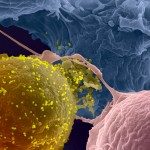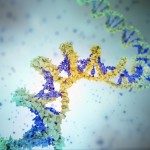Link to Pubmed [PMID] – 38563763
Link to DOI – 10.1128/jvi.01693-23
J Virol 2024 Apr; (): e0169323
In the early COVID-19 pandemic with urgent need for countermeasures, we aimed at developing a replicating viral vaccine using the highly efficacious measles vaccine as vector, a promising technology with prior clinical proof of concept. Building on our successful pre-clinical development of a measles virus (MV)-based vaccine candidate against the related SARS-CoV, we evaluated several recombinant MV expressing codon-optimized SARS-CoV-2 spike glycoprotein. Candidate V591 expressing a prefusion-stabilized spike through introduction of two proline residues in HR1 hinge loop, together with deleted S1/S2 furin cleavage site and additional inactivation of the endoplasmic reticulum retrieval signal, was the most potent in eliciting neutralizing antibodies in mice. After single immunization, V591 induced similar neutralization titers as observed in sera of convalescent patients. The cellular immune response was confirmed to be Th1 skewed. V591 conferred long-lasting protection against SARS-CoV-2 challenge in a murine model with marked decrease in viral RNA load, absence of detectable infectious virus loads, and reduced lesions in the lungs. V591 was furthermore efficacious in an established non-human primate model of disease (see companion article [S. Nambulli, N. Escriou, L. J. Rennick, M. J. Demers, N. L. Tilston-Lunel et al., J Virol 98:e01762-23, 2024, https://doi.org/10.1128/jvi.01762-23]). Thus, V591 was taken forward into phase I/II clinical trials in August 2020. Unexpected low immunogenicity in humans (O. Launay, C. Artaud, M. Lachâtre, M. Ait-Ahmed, J. Klein et al., eBioMedicine 75:103810, 2022, https://doi.org/10.1016/j.ebiom.2021.103810) revealed that the underlying mechanisms for resistance or sensitivity to pre-existing anti-measles immunity are not yet understood. Different hypotheses are discussed here, which will be important to investigate for further development of the measles-vectored vaccine platform.IMPORTANCESARS-CoV-2 emerged at the end of 2019 and rapidly spread worldwide causing the COVID-19 pandemic that urgently called for vaccines. We developed a vaccine candidate using the highly efficacious measles vaccine as vector, a technology which has proved highly promising in clinical trials for other pathogens. We report here and in the companion article by Nambulli et al. (J Virol 98:e01762-23, 2024, https://doi.org/10.1128/jvi.01762-23) the design, selection, and preclinical efficacy of the V591 vaccine candidate that was moved into clinical development in August 2020, 7 months after the identification of SARS-CoV-2 in Wuhan. These unique in-human trials of a measles vector-based COVID-19 vaccine revealed insufficient immunogenicity, which may be the consequence of previous exposure to the pediatric measles vaccine. The three studies together in mice, primates, and humans provide a unique insight into the measles-vectored vaccine platform, raising potential limitations of surrogate preclinical models and calling for further refinement of the platform.

















